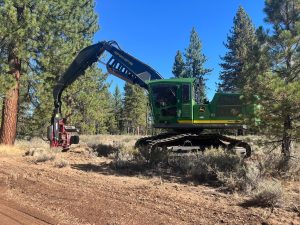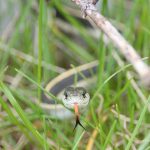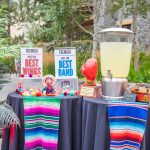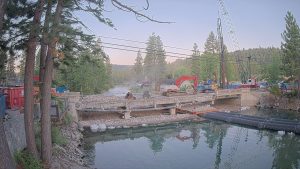Year of the Snake; A guide to the basin’s slithery friends
According to the Chinese Zodiac, 2025 is the Year of the Snake, which symbolizes calmness, strategy, and introspection. Running on a 12-year cycle, a few public figures born in the Year of the Snake include Taylor Swift, Nora Ephron, and Bob Dylan. Snakes are cunning, intelligent, and creative, traits that not only apply to people born within a Year of the Snake but also to the actual physical reptiles that are becoming more prominent in the Tahoe Sierra.
In Tahoe, we have five different kinds of snakes including three kinds of garter snakes, rubber boas, and western rattlesnakes. They hang out on different mountaintops and a big concentration of them are in wet areas.
Garter snakes hang out closer to water, while rattlesnakes are found on the western slope of Tahoe—and people are spotting more of them each year.

“They’ve been seen in Bijou and are becoming more prevalent than they’ve ever been. As regions get warmer, they are making their way up to higher elevations,” says Tahoe Institute for Natural Science (TINS) Outreach Director Sarah Hockensmith.
Hockensmith adds they’ve been spotted at places like Loch Leven Lakes (in Emigrant Gap) and the Lover’s Leap in higher concentrations; just last summer, local fly fisherman Matt Heron found a massive rattlesnake on the Truckee River near Boca Bridge.
“[Rattlesnakes] are certainly around up in the Tahoe environment and moving up over the crest,” TINS Executive Director T. Will Richardson confirms.
The uptick in snake sightings is “unequivocally attributed to climate change,” Richardson also affirms. All five species of snakes in the Truckee/Tahoe area are adapted to cold temperatures and they’re ovoviviparous, meaning their eggs hatch internally giving them a thermal advantage.
There are no records of rattlesnakes being seen in the Tahoe Sierra prior to 2015, and after that first one was spotted in Bijou, it they started trickling in. There are a few hot spot areas, such as around Pyramid Peak, within a chunk of Desolation Wilderness, Serene Lakes (in the Soda Springs area), and Richardson also brought up Loch Leven where someone’s dog got bit by a rattlesnake back in 2016.
However, if you ask Hockensmith what the most dangerous animal in Tahoe is, she’ll say it’s the rodents.
“They carry diseases and that’s why snakes are important to have around…they are a predator to those rodents,” she explains.
We host at least six different species of chipmunks just in the Sierra Nevada specifically—and have the largest diversity of squirrels in all of California—and rattlesnakes are important to have in our environment to keep rodent populations down. Rattlesnakes are fairly good at giving us a warning when we get too close to them as well.
“They shake their rattle, but a lot of times people have their Airpods in and don’t hear it,” Hockensmith says.
When asked if people should bring anything on their hikes with them in case they get bit, Richardson says people should bring their awareness.
“Bites occur when people are messing with them. They just want to be left alone. Their rattle is their defense mechanism… they just don’t want to get stepped on,” he says.
Rubber Boas
Brownish-gray rubber boas are also common in Tahoe, more on the southwest side of the lake up by Desolation Wilderness. Rubber boas have hard caps on either end, making their head look like their tail.
“It’s a deliberate adaptive trait that helps them go after a nest and use their tail as a distraction,” Richardson says. The mice will attack the tail thinking it’s the face while the snake curls in from the other side and eats the babies. “You see rubber boas and their tails will be all roughed up,” he adds.
Boas can live for a long time, the oldest known one being 70-plus years old.
“I have them in my yard in Glenshire; whenever I see a big one, I just wonder how old it is,” Richardson comments. Unfortunately, since boas are most active at night, a lot end up as roadkill. Reptiles evolved to suck up warmth from pavement, so they tend to come out more often in the late summer late afternoons.
They are also the friendliest of the Tahoe snakes.
“I’ve never even heard of an attack…they appreciate the warmth of your hand and will curl up in it. “They have a very sweet disposition. They’ll be the ones that we use to help people get over their fear of snakes,” Richardson adds.
Garter Snakes
There are three different kinds of garter snakes in Tahoe—the mountain garter, valley garter, and the Sierra garter.
Mountain garter snakes have a mild neurotoxin in their venom that’s not dangerous to humans but helps them process frogs, insects, and other vertebrates.
“The garters poop on you as a defense mechanism…it smells so bad that you’ll want to put them down,” Hockensmith says.
“I learned during COVID that hand sanitizer is one of the only things that helps get that smell off your hand…you may need something stronger than soap and water,” Richardson says.
The Sierra garter is the aquatic one…as well as the most feisty and aggressive.
“You pick them up and they don’t know what’s going on, they probably think you’re like a hawk trying to haul them off and eat them. And depending what state you’re in, if they are shedding their skin then they may be more irritable,” Richardson adds.
He affirms they do have a mild venom that people may react differently to.
“If one is gnawing on your finger then it may feel a little itchy afterward,” Richardson explains, mentioning that’s how he reacted the last time he handled a spirited garter snake.
Going Back to Rattlesnakes
The best way to not get struck by a rattlesnake is to avoid getting bitten in the first place by being aware and keeping your distance. Snakebites are rare but if one does get their fangs in you then it’s best to stay calm, avoid putting pressure on the wound, and get to a hospital as soon as possible.
Most rattlesnakes will do dry strikes, meaning they may bite but not produce any venom.
“Venom is metabolically expensive for them to produce. It’s basically modified saliva, and they use it to break down their food. But I’ve heard that young ones can’t control their venom, so they’re more likely to strike with it,” Richardson says.
There’s currently a debate over the taxonomy of rattlesnakes right now—they seem to be coming up from the West and Northern Pacific, different from the snakes on the Nevada side.
“They’re starting to show up more often on Kingsbury Grade and in Glenshire,” he adds.
“We’ll be starting to see gopher snakes turning up in Tahoe. Rattlesnakes are already being spotted on the upper reaches of General Creek and there was one recently at Fallen Leaf Lake. Sightings will become more widespread.”
When asked what he thinks the most dangerous animal in the Truckee/Tahoe area is, without skipping a beat Richardson replies, “humans.” He says his number two is potentially rodents, as a group.
“They carry the bubonic plague around, the hantavirus, and Tahoe is a hotbed for relapsing tick fever. Relapsing tick fever is a nightmare thing. It’s like the flu, but then it comes back over and over again. And unless you send your blood off to the CDC, you may never know what it is. Tick-borne diseases are no good.
“I’d rather have the occasional startle and thrill of spooking a rattlesnake than risk getting bubonic plague…I think we could use some more natural predators for the rodents,” Richardson suggests.
For more information about the Tahoe Institute for Natural Science, visit https://www.tinsweb.org/.
Editor’s note: This article originally appeared in the Summer 2025 edition of Tahoe Magazine.
Support Local Journalism


Support Local Journalism
Readers around Lake Tahoe, Truckee, and beyond make the Sierra Sun's work possible. Your financial contribution supports our efforts to deliver quality, locally relevant journalism.
Now more than ever, your support is critical to help us keep our community informed about the evolving coronavirus pandemic and the impact it is having locally. Every contribution, however large or small, will make a difference.
Your donation will help us continue to cover COVID-19 and our other vital local news.








